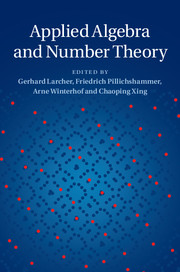Book contents
- Frontmatter
- Contents
- Preface
- 1 Some highlights of Harald Niederreiter's work
- 2 Partially bent functions and their properties
- 3 Applications of geometric discrepancy in numerical analysis and statistics
- 4 Discrepancy bounds for low-dimensional point sets
- 5 On the linear complexity and lattice test of nonlinear pseudorandom number generators
- 6 A heuristic formula estimating the keystream length for the general combination generator with respect to a correlation attack
- 7 Point sets of minimal energy
- 8 The cross-correlation measure for families of binary sequences
- 9 On an important family of inequalities of Niederreiter involving exponential sums
- 10 Controlling the shape of generating matrices in global function field constructions of digital sequences
- 11 Periodic structure of the exponential pseudorandom number generator
- 12 Construction of a rank-1 lattice sequence based on primitive polynomials
- 13 A quasi-Monte Carlo method for the coagulation equation
- 14 Asymptotic formulas for partitions with bounded multiplicity
- 15 A trigonometric approach for Chebyshev polynomials over finite fields
- 16 Index bounds for value sets of polynomials over finite fields
- 17 Rational points of the curve over
- 18 On the linear complexity of multisequences, bijections between ℤahlen and ℕumber tuples, and partitions
- Plate section
- References
10 - Controlling the shape of generating matrices in global function field constructions of digital sequences
Published online by Cambridge University Press: 18 December 2014
- Frontmatter
- Contents
- Preface
- 1 Some highlights of Harald Niederreiter's work
- 2 Partially bent functions and their properties
- 3 Applications of geometric discrepancy in numerical analysis and statistics
- 4 Discrepancy bounds for low-dimensional point sets
- 5 On the linear complexity and lattice test of nonlinear pseudorandom number generators
- 6 A heuristic formula estimating the keystream length for the general combination generator with respect to a correlation attack
- 7 Point sets of minimal energy
- 8 The cross-correlation measure for families of binary sequences
- 9 On an important family of inequalities of Niederreiter involving exponential sums
- 10 Controlling the shape of generating matrices in global function field constructions of digital sequences
- 11 Periodic structure of the exponential pseudorandom number generator
- 12 Construction of a rank-1 lattice sequence based on primitive polynomials
- 13 A quasi-Monte Carlo method for the coagulation equation
- 14 Asymptotic formulas for partitions with bounded multiplicity
- 15 A trigonometric approach for Chebyshev polynomials over finite fields
- 16 Index bounds for value sets of polynomials over finite fields
- 17 Rational points of the curve over
- 18 On the linear complexity of multisequences, bijections between ℤahlen and ℕumber tuples, and partitions
- Plate section
- References
Summary
This paper is dedicated to H. Niederreiter on the occasion of his 70th birthday.
Abstract
Motivated by computational as well as theoretical considerations, we show how the shape and density of the generating matrices of two optimal constructions of (t, s)-sequences and (u, e, s)-sequences (the Xing–Niederreiter and Hofer–Niederreiter sequences) can be controlled by a careful choice of various parameters. We also present some experimental data to support our assertions and point out open problems.
Introduction
The usefulness of and need for well-distributed pseudorandom and quasi-random point sets in very high dimensions has been evidenced by the unbroken stream of publications and conferences with the topic of Monte Carlo and quasi-Monte Carlo (MCQMC) methods in scientific computing, most notably the biannual conference series and proceedings of the same name. Beginning with the well-known Koksma–Hlawka inequality up to the more recent higher order nets, it became clear that, in particular, applications pertaining to multivariate numerical integration are an important area covered by MCQMC methods. Numerous applications in diverse areas of applied mathematics profit from this fact; often cited are applications in finance, computer aided visualization and simulations. (The reader is referred to [5], [4], and [18].)
As regards the suitability of even arbitrary point sets for MCQMC methods, the notion of discrepancy is well established as a measure for the degree of equidistribution, which significantly determines, for example, the error of numerical integration. In brief, discrepancy can be defined as measuring the worst case integration error when applied to indicator functions of subintervals of the unit cube. When the coordinates of the intervals are restricted to b-adic rationals, we arrive at the notion of (t, s)-sequences (in base b)[16]; if, furthermore, a different granularity is permitted in different coordinates, we arrive at the recent refinement of (u, e, s)-sequences [10, 26].
We review the definitions of these concepts in more detail. In the following, let b ∈ ℕ {1}; N, m, s ∈ ℕ t, u ∈ ℕ0 and q ∈ ℕ a prime power.
Information
- Type
- Chapter
- Information
- Applied Algebra and Number Theory , pp. 164 - 189Publisher: Cambridge University PressPrint publication year: 2014
